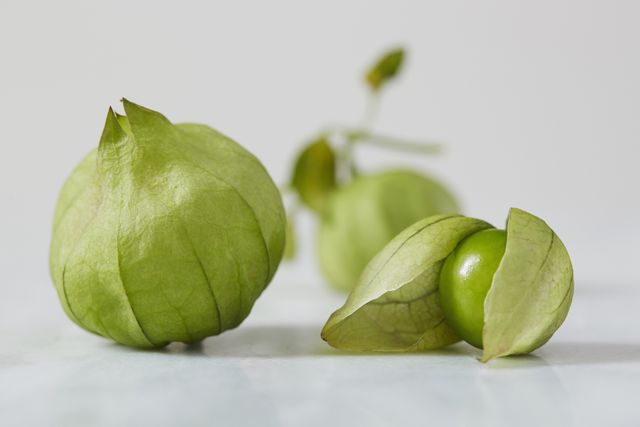Surprise: The essential ingredient in the green salsa recipes of Mexican cuisine is not green tomatoes, but fresh tomatillos — fruit with a citrusy sweet flavor. Dainty paper husks encase the tomatillo, and by late summer, what seems like billions of fruits dangle from the plant's branches.
Background
Native to Mexico and domesticated by the Aztecs around 800 B.C., the tomatillo is one of our most ancient food bearing plants. Today, gardening gurus can grow seeds of varieties from the same two species the Aztecs grew. Physalis ixocarpa is commonly sold in markets and has large (up to 2 ½-inch-diameter) tart green fruits, which ripen to pale yellow. Physalis philadelphica produces sweeter, marble-size purple fruits. This species is a common field weed grown in Mexico, but the taste is no less delicious.
Choosing A Growing Site
Select a growing area with full sun exposure and well-drained, moderately rich soil. The tomatillo is a lighter feeder than tomatoes, and while they are tough semi-wild plants, they do not fare well in soggy, poorly drained soil. Work a couple inches of compost into the soil before planting seeds, and fork deeply to improve drainage. Raised beds work great for the tomatillo plant if your garden has heavy clay soil.
Related: Cherry Tomatoes: The Easiest Plant You'll Ever Grow
Planting
Start tomatillo seeds indoors six to eight weeks before your last frost date. Harden off indoor-started plants before transplanting outdoors to the garden. Set out at the same time you plant your tomatoes, when all danger of frost is past and the soil is thoroughly warm.
Tomatillos are much like their nightshade family cousin the tomato, in that the plant sprouts roots along the stems, so it profits from being planted deeply in the garden. The indeterminate, sprawling plants grow 3 to 4 feet tall and at least as wide, so space the plants 3 feet apart in rows 3 to 4 feet apart. Plan to give them support in the form of gardening trellises or tomato cages, unless you want to harvest the ripe fruits off the ground. Two to four plants are sufficient for fresh use.
(Sign up for our FREE newsletter to get clever kitchen tricks, gardening secrets, and more delivered straight to your inbox!)
Growing
Tomatillos are hugely prolific and produce nonstop until laid low by frost. Start by applying 2 to 3 inches of organic mulch, such as grass clippings, to suppress weeds and keep the soil moist. Although moderately drought-tolerant, tomatillos do best with an inch or so of water per week. If space is limited, pinch off the growing tips to control spread. Fertilizer is not needed.
Related: The 1 Thing In Your Garden You're Not Paying Enough Attention To
Gardening master’s tip
When frost threatens, pull up your tomatillo plants and hang them upside down in an unheated garage. The tomatillo fruits will keep for at least a couple of months.
Harvesting
You'll be preparing your first organic salsa verde about 75 to 100 days after transplanting seedlings. Harvest tomatillos when they fill out their husks and the husks just begin to split. If the fruits feel like mini marbles inside loose husks, wait awhile, but harvest before they turn pale yellow, as they become seedier and their flavor loses the desired tanginess as they ripen. Store harvested tomatillos in their husks at room temperature for up to a week or in the refrigerator for up to three weeks.
Newbie hint
Harvest all your ripe tomatillos to prevent a forest of self-sown seedlings next year. Consign overripe and rotten tomatillo fruits to your hot compost heap.
Related: How To Grow Organically On A Budget
Recommended Varieties
Toma Verde is the standard large-fruited tomatillo variety, with golf-ball-size, tart green fruits. They're ready extra early, at 60 days from transplanting.
Purple tomatillo varieties have small, intensely purple fruits and green husks. They're highly decorative and long-storing and are ready at 65 days from transplant. This variety grows particularly well in a container.
Upkeep
Though the tomatillo seems like some exotic vegetable, they are popular with beginner gardeners, because they rarely suffer disease or insect pest problems. Cage the plants off the ground to allow air to circulate—which protects them from diseases, such as early blight—and to keep them out of reach of slugs and snails. The tomatillo plants aren't as heavy as tomato plants, and the undersize wire cages typically sold for tomatoes work fine for supporting tomatillos.
Problem Solving
Tomatillos are not self-pollinating like their tomato cousins. In order for the tomatillo flowers to set fruit, you must grow at least two plants. Otherwise, you'll be left with lots of pretty little yellow flowers and none of the tasty green edible fruit.
Related: How To Grow Ground Cherries
Preparation Techniques
Preparing tomatillos for cooking or storage is easy. Just remove the papery husks and wash the sticky fruits inside. Tomatillos need no coring or seeding before being incorporated into your favorite recipe. To freeze, simply place washed, dry tomatillos in freezer bags and seal. Although tomatillos are usually cooked, they can also be eaten raw. Garden fresh tomatillos add zest and unique flavor to hot sauces, salsas, and dips. Break out your favorite Mexican cookbook and try some new recipes, or use these ideas as inspiration.
Guacamole Light Recipe
Make a lower calorie guacamole by replacing half the avocado with chopped raw tomatillos.
Smoky Grilled Tomatillo Salsa Recipe
Roast a large unpeeled onion, five unpeeled garlic cloves, two to five chile peppers (such as serrano, poblano, or anaheim), and 1 pound tomatillos on a charcoal grill until charred and soft. Peel the onion, garlic, and peppers and cut into chunks. Pulse all ingredients briefly in a food processor along with sea salt, a handful of cilantro, and a generous squirt of fresh lime juice. Serve with chips or use to top your favorite chicken tacos.
Related Recipe: Roasted Tomatillo Salsa Verde
Crisp Fried Tomatillos Recipe
Even better than a fried green tomato! Halve the fruits. Beat an egg with a ½ cup of milk. Prepare a shallow bowl of seasoned flour and another of cornmeal. Toss the fruits first in flour, then in the egg mixture, then roll in cornmeal. Fry in olive oil in a nonstick skillet until crisp and golden. Serve on top of a salad, or as a garnish for a soup. Or just snack on them while out in the garden.
Green Rice Recipe
Puree 2½ cups raw tomatillos with ten cilantro sprigs. Measure 2 cups of this puree. In a medium saucepan, sautée a finely chopped small onion in 1 tablespoon olive oil until soft. Add 1 cup rice and cook, stirring, five minutes longer. Add the puree and 1 teaspoon salt, cover, and bring to a boil. Reduce heat to low and cook 20 to 30 minutes, until all liquid is absorbed.
Related: 9 Spicy Fruit Salsas You'll Want To Eat All Summer Long
Terrific Trio Recipe
Combine tomatillos, cilantro, and onion for a classic salsa combo.













